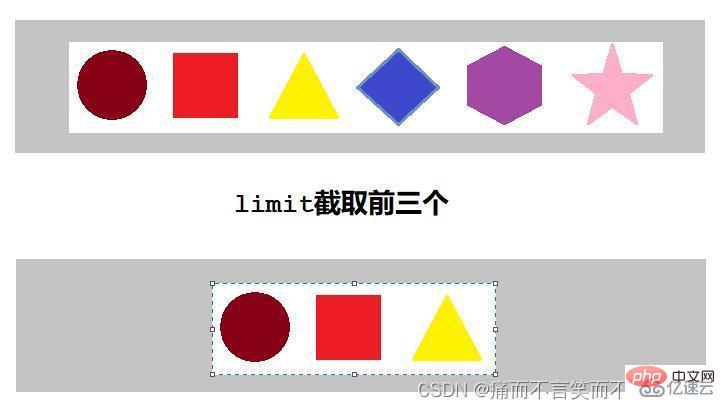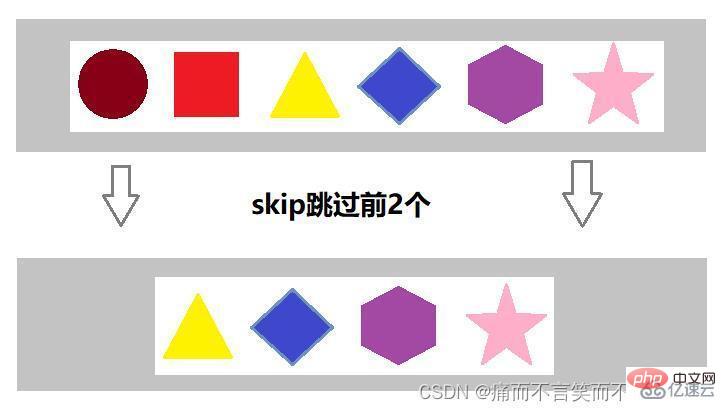Home >Java >javaTutorial >How to use the new feature Stream in Java8
How to use the new feature Stream in Java8
- 王林forward
- 2023-05-11 13:40:061283browse

The concept of Stream flow
Why use Stream flow?
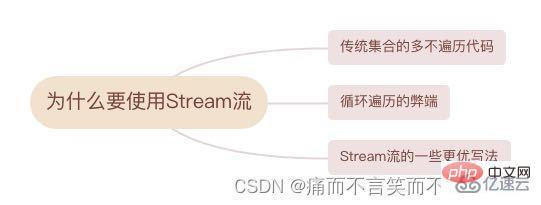
#The idea of Stream flow is similar to the assembly line of a production workshop. When we need to operate multiple elements (especially multi-step operations), considering performance and convenience, we should first put together a "model" step-driven plan, and then execute it according to the plan.
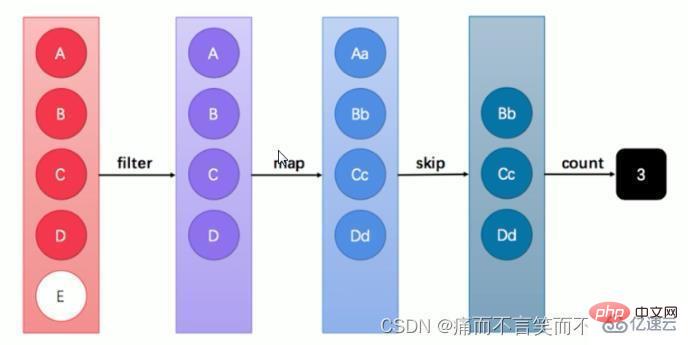
Stream(Stream) is a queue of elements from the data source
The elements are Objects of a specific type, forming a queue. Stream in lava does not store elements, but calculates them on demand.
Data source The source of the stream. Can be a collection, array, etc.
Two basic characteristics of Stream:
·Pipelining:Intermediate operations will return the stream object itself. In this way, multiple operations can be connected into a pipeline, just like fluent style. Doing so can optimize operations such as laziness and short-circuiting.
Internal iteration: In the past, collection traversal was explicitly iterated outside the collection through iterator or enhanced for. This is called external iteration. Stream provides an internal iteration method, and the stream can directly call the traversal method.
When using a stream, it usually includes three basic steps: Obtain a data source (source)→Data conversion: Perform an operation to obtain the desired result. Each time the original Stream object is converted, the original Stream object is converted. Change, returning a new Stream object (which can have multiple conversions), which allows operations on it to be arranged like a chain and become a pipeline.
Acquisition of Stream stream
There are two common ways to obtain a stream:
1. Obtain through Collection collection
2.Stream interface The static method of get
Get through the Collection collection
All Collection collections can get the stream through the stream default method
//把集合转换为stream流 //list集合 List<String>list=new ArrayList<>(); Stream<String>stream=list.stream(); //set集合 Set<String>set=new HashSet<>(); Stream<String>stream2=set.stream(); //map集合(map集合需要间接的转换) Map<String, String>map=new HashMap<>(); //方法一:获取键,存储到一个set集合中 Set<String>keySet=map.keySet(); Stream<String>stream3=keySet.stream(); //方法二:获取值,存储到一个collection集合中 Collection<String>values=map.values(); Stream<String>stream4=values.stream(); //方法三:获取键值对,,键与值的映射关系,entrySet() Set<Map.Entry<String, String>>entries=map.entrySet(); Stream<Map.Entry<String, String>>stream5=entries.stream();
2 The static method of of the .Stream interface gets
The static method of of the Stream interface can get the stream corresponding to the array.
The parameter is a variable parameter, then we can pass an array
//把数组转换成Stream流 Stream<Integer>stream6=Stream.of(1,2,3,4,5); //可变参数可以传递数组 Integer[]arr={1,2,3,4,5}; Stream<Integer>stream7=Stream.of(arr); String[]arr2={"a","bb","ccc"}; Stream<String>stream8=Stream.of(arr2);
Common methods of stream stream
The common methods of stream are divided into two categories:
Delayed method: The return value type is still the method of the Stream interface itself, so chained calls are supported. (Except for the final method, all other methods are delayed methods.)
Terminator method: The return value type is no longer a method of the Stream interface's own type, so it no longer supports methods like StringBuilder Chain calls.
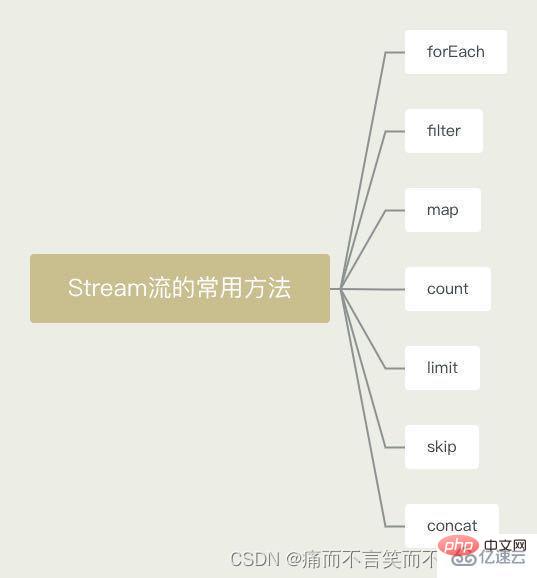
The above are some common methods of stream. Let’s learn how to use these methods in turn.
forEach traversal method
This method accepts a Consumer interface function and will hand over each stream element to the function for processing. The Consumer interface is a consumer functional interface that can pass lambda expressions and consume data.
foeeach method is used to traverse the data in the stream. It is a termination method. After traversing, other methods in the stream cannot be used.
Basic usage
public class Demo03Stream_forEach { public static void main(String[] args) { Stream<String>stream=Stream.of("张三","李四","王五","赵六","小明","小胖"); /*stream.forEach((String name)->{ System.out.println(name); });*/ stream.forEach(name->System.out.println(name)); } }
filter filtering method
is used to filter the numbers in the Stream. The parameter Predicate of the filter method is a functional interface, so lambda expressions can be passed to filter the data. You can filter a conversion into the next stream through the filter method, as shown below:
The above picture filters some different elements using the filter method, and then becomes New stream.
Basically use
public class Demo04Stream_filter { public static void main(String[] args) { //创建一个Stream流 Stream<String>stream=Stream .of("张三丰","赵敏","张无忌","周芷若","张三","狮王","张大牛"); //对Stream流中的元素进行过滤。只要张的人 Stream<String>stream2=stream.filter((String name)->{return name.startsWith("张");}); //遍历Stream流 stream2.forEach(name->System.out.println(name)); } }
map mapping method (conversion)
if needed To convert elements in a stream to another stream, you can use the map method. This interface requires a Function functional interface parameter, which can convert the T type data type in the current stream to another R type data stream, as shown below:
Above A graph converts data from different elements into elements of one type.
Basic usage
public class Demo05Stream_map { public static void main(String[] args) { //获取一个String类型的Stream流 Stream<String>stream=Stream.of("1","2","3","4","5"); //使用map方法,把字符串类型的整数,转换(映射)为integer类型的整数 Stream<Integer>stream2=stream.map((String s)->{ return Integer.parseInt(s); }); //遍历Stream流 stream2.forEach(i->System.out.println(i)); } }
count method of counting the number of elements
is used Count the number of elements in the Stream. The count method is a final method, and the return value is an integer of type Long. So you can no longer call other methods in the Stream stream
Basic use
public class Demo06Stream_count { public static void main(String[] args) { //获取一个Stream流 ArrayList<Integer>list=new ArrayList<Integer>(); //添加元素 list.add(1); list.add(2); list.add(3); list.add(4); list.add(5); list.add(6); list.add(7); Stream<Integer>stream=list.stream(); //统计stream流中的元素个数 long count=stream.count(); //打印输出 System.out.println(count);//7 } }
limit截取流元素方法
Limit方法可以对流进行截取,只取用前n个。参数是一个long型,如果集合当前长度大于参数则进行截取,否则不进行操作。limit方法是一个延迟方法,只是对流中的元素进行截取,返回一个新的流,使用可以继续调用stream流中的其他方法。
基本使用
public class Demo07Stream_limit { public static void main(String[] args) { show02(); } private static void show02() { //创建一个String类型的数组 String[]arr={"喜羊羊","美羊羊","沸羊羊","懒羊羊","灰太狼","红太狼"}; //集合获取一个Stream流 Stream<String>stream=Stream.of(arr); //用limit方法截取前6个元素 Stream<String>stream2=stream.limit(3); //遍历Stream2流 stream2.forEach(i->System.out.println(i)); } }
skip跳过元素方法
如果希望跳过前几个元素,可以使用skip方法获取一个截取之后的新流,如果流的当前长度大于n,则跳过前n个;否则将会得到一个长度为0的流。
基本使用
public class Demo08Stream_skip { public static void main(String[] args) { //创建一个String类型的数组 String[]arr={"喜羊羊","美羊羊","懒羊羊","慢羊羊","红太狼","灰太狼","小灰灰","沸羊羊","软绵绵","武大狼"}; //获取Stream流 Stream<String>stream=Stream.of(arr); //使用skip方法截取后面的元素 Stream<String>stream2=stream.skip(5); //遍历stream2流 stream2.forEach(i->System.out.println(i)); } }
concat:合并方法
用于把流组合到一块。如果有两个流,希望合并成为一个流,就可以使用concat方法
基本使用
public class Demo09Stream_concat { public static void main(String[] args) { //创建一个Stream流 Stream<String>stream=Stream.of("张三丰","张翠山","赵敏","周芷若","张无忌"); //创建一个String类型的数组 String[]arr={"喜羊羊","美羊羊","懒羊羊","慢羊羊","红太狼","灰太狼","小灰灰","沸羊羊","软绵绵","武大狼"}; //获取Stream流 Stream<String>stream2=Stream.of(arr); //使用常用方法concat方法合并流 Stream<String>stream3=Stream.concat(stream, stream2); //遍历Stream3流 stream3.forEach(i->System.out.println(i)); } }
Stream流的练习
最后,我们通过下面的练习来巩固一下上面所学的内容。
现在有两个ArrayList集合存储队伍当中的多个成员姓名,
要求使用传统的for循环(或增强for循环)依次进行以下若干操作步骤:
1.第一个队伍只要名字为3个字的成员姓名:存储到一个新集合中。
2.第一个队伍筛选之后只要前3个人;存储到一个新集合中。
3.第二个队伍只要姓张的成员姓名;存储到一个新集合中。
4.第二个队伍筛选之后不要前2个人;存储到一个新集合中。
5.将两个队伍合并为一个队伍;存储到一个新集台中。
6.根据姓名创建Person对象:存储到一个新集合中,
7.打印整个队伍的Person对象信息。
示例:
第一支队伍:迪丽热巴、宋远桥、苏星河、石破天、石中玉、老子、庄子、洪七公
第二支队伍:古娜力扎、张无忌、赵丽颖、张三丰、尼古拉斯赵四、张天爱、张二狗
首先创建Person对象类
public class Person {
private String name;
public Person() {
super();
}
public Person(String name) {
super();
this.name = name;
}
public String getName() {
return name;
}
public void setName(String name) {
this.name = name;
}
@Override
public String toString() {
return "Person [name=" + name + "]";
}
}然后再根据习题要求用Stream流进行过滤
1.第一个队伍只要名字为3个字的成员姓名:存储到一个新集合中。
2.第一个队伍筛选之后只要前3个人;存储到一个新集合中。
// 第一支队伍
// 创建集合
ArrayList<String> one = new ArrayList<>();
// 添加元素
one.add("迪丽热巴");
one.add("宋远桥");
one.add("苏星河");
one.add("石破天");
one.add("石中玉");
one.add("老子");
one.add("庄子");
one.add("洪七公");
//1.第一个队伍只要名字为3个字的成员姓名:存储到一个新集合中。
//2.第一个队伍筛选之后只要前3个人;存储到一个新集合中。
Stream<String>oneStream=one.stream().filter(name->name.length()==3).limit(3);3.第二个队伍只要姓张的成员姓名;存储到一个新集合中。
4.第二个队伍筛选之后不要前2个人;存储到一个新集合中。
// 第二支队伍
// 创建集合
ArrayList<String> tow = new ArrayList<>();
// 添加元素
tow.add("古娜力扎");
tow.add("张无忌");
tow.add("赵丽颖");
tow.add("张三丰");
tow.add("尼古拉斯赵四");
tow.add("张天爱");
tow.add("张二狗");
//3.第二个队伍只要姓张的成员姓名;存储到一个新集合中。
//4.第二个队伍筛选之后不要前2个人;存储到一个新集合中。
Stream<String>towStream=tow.stream().filter(name->name.startsWith("张")).skip(2);5.将两个队伍合并为一个队伍;存储到一个新集台中。
6.根据姓名创建Person对象:存储到一个新集合中,
7.打印整个队伍的Person对象信息。
//5.将两个队伍合并为一个队伍;存储到一个新集台中。 //6.根据姓名创建Person对象:存储到一个新集合中, //7.打印整个队伍的Person对象信息。 Stream.concat(oneStream,towStream).map(name->new Person(name)).forEach(p->System.out.println(p));
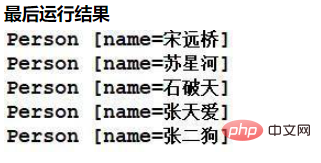
The above is the detailed content of How to use the new feature Stream in Java8. For more information, please follow other related articles on the PHP Chinese website!




